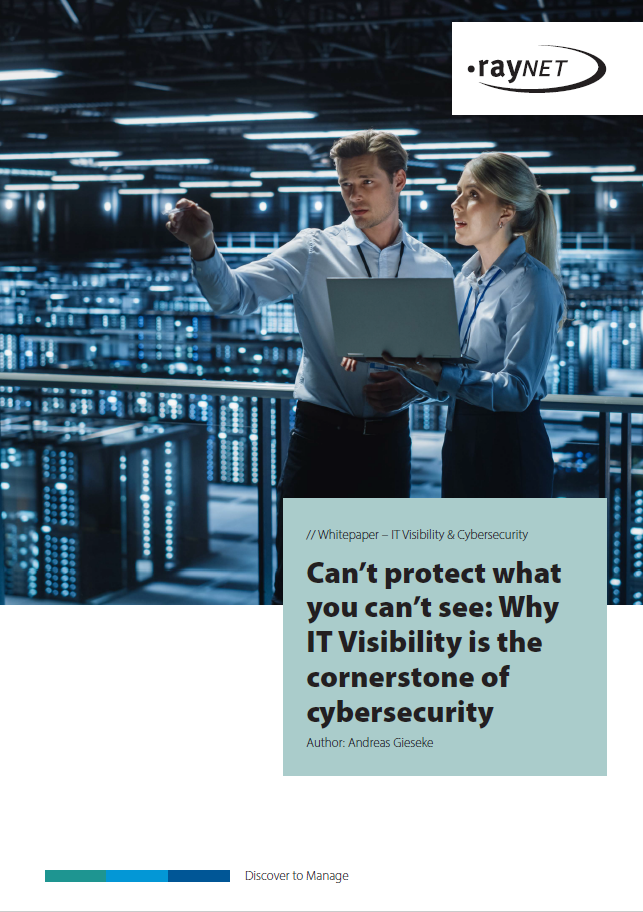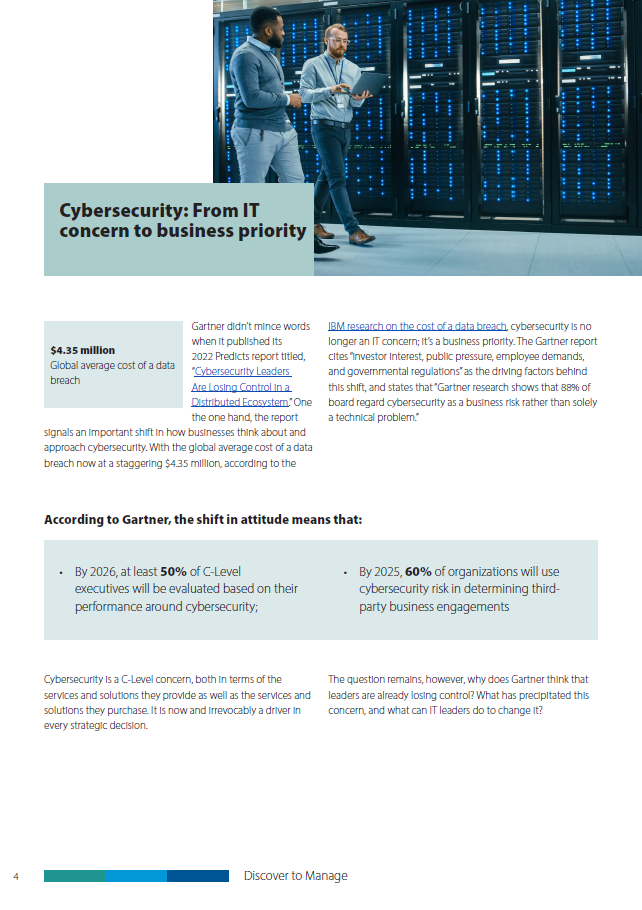How IT Visibility protects your business IT from security threats
Date: June 6th, 2023
In 2022, 17% of all cyberattacks were executed by ransomware. The average duration of such an attack has reduced dramatically in recent years. In 2019, for example, it was still more than 65 days from the time of a vulnerability to the final cyberattack. Today, it’s less than 3.85 days an organization has time to react to vulnerabilities. (Source: IBM Threat Intelligence Report)
Source: IBM Threat Intelligence Report
Despite the increasing sophistication of cybersecurity tools, cyberattacks are increasing both in number and severity, and they are getting faster. The growing complexity of IT infrastructures along with the centrality of digital solutions in almost every aspect of our work leave enough room for gaps, which bad actors can exploit to gain access to critical infrastructure.
One might think that a firewall would be enough. After all, if you have a high enough fence between you and the outside world, you should be able to control who and what gets in. But this assumes that we know what needs to be protected. Although a firewall might be nearly impenetrable, if it doesn’t surround the complete environment, then the resulting security gaps leave resources open to intrusion and attack.
Similarly, you can only patch what you know about. Unknown devices and unknown software applications won’t be integrated into regular patching activities. If you don’t have a complete inventory, then you have likely left crucial pieces of your infrastructure unsecured.
The larger and more complex the environment, the harder it is to secure. There’s more to see, more opportunities for blind spots, and thus more potential security gaps. Getting visibility on potential attack surfaces is even more crucial because most attacks aren’t sophisticated. Bad actors don’t rely on cutting-edge hacking techniques to gain access to sensitive data and systems. They take the easiest route, exploiting common vulnerabilities that, for one reason or another, organizations aren’t quick to remediate, and using phishing schemes to trick users into unwittingly revealing their credentials.
This is why visibility is the first step to ensuring cybersecurity. By finding your blind spots, you reduce your attack surface and make your organization a less appealing target.
How do I know if I have a critical IT Visibility gap?
If you answer “no” to any of these questions, then you might have a visibility gap in your infrastructure that could significantly increase your security risks:
- Do I have a record of every device that’s connected to my network?
- Do I know what software is installed on my end devices?
- Do I know key information about that software, including, End-of-Life & End-of-Support dates, support status, patch status, etc.?
- Can I easily identify known vulnerabilities for every device and every software title installed or running on my devices?
- Do I have an antivirus program installed on each device and is it up to date?
A lack of visibility over any of this information increases your attack surface. An unknown device or unknown software application could open the door to countless vulnerabilities, giving bad actors access to crucial data to leak, sell, or ransom.
Author:
Related links:
Share blog:
Can't protect what you can't see: Why IT Visibility is the cornerstone of cybersecurity
In this whitepaper, we’ll show you how blind spots can weaken and even threaten your infrastructure. But we’ll also show you how IT Visibility can:
- Improve your security strategy
- Reveal hidden gaps and blind spots in your existing security measures
- Maintain business flexibilities
- Ensure your competitive edge
How does End-of-Life & End-of-Support Monitoring improve cybersecurity?
When software products reach End-of-Life (EoL) or End-of-Support (EoS), they no longer receive security patches and updates from the manufacturer, leaving your infrastructure potentially vulnerable. By getting a complete overview of EoL and EoS information, you can manage vulnerable software and create a risk mitigation strategy.
What can infrastructure technical debt management contribute to IT security?
Legacy software and infrastructure have reached their End-of-Life and End-of-Support. If you aren’t providing support yourself, tracking and patching vulnerabilities and fixing bugs, then you have an increased attack surface and an increased cybersecurity risk. Out of date software and infrastructure can also consume your support resources, slowing response times and opening additional attack surfaces.
How does Vulnerability Monitoring keep my infrastructure safe?
Proactively managing your cybersecurity risks means knowing what risks are already in your infrastructure, scoring that risk, and then planning to mitigate it. You can enrich your comprehensive software and hardware inventory with vulnerability information to see where your risk is. Criticality scoring allows you to visualize the severity of your risk, making it easier to plan and prioritize your risk mediation strategy.
Is Application Rationalization important for securing my business IT?
Maintaining visibility over your application portfolio is easier when the portfolio is rationalized. This means keeping only the products you need and use to drive your business. Anything else should be removed, so you can reduce the amount of time and effort needed to patch software as well as to reduce your attack surface. The smaller and more manageable your portfolio, the easier it is to keep secure.
Is Shadow IT making my infrastructure more vulnerable?
Any technology, including software, systems, and end devices that are used in your organization without the knowledge approval, or oversight of central IT is known as Shadow IT. Shadow IT increases your attack surface because it’s not covered by your routine security protocols. For instance, if central IT doesn’t know an application is installed, then they won’t know to patch it. Shadow cloud applications won’t be connected to your SSO. Shadow devices may not have adequate antivirus protection. If your central IT doesn’t know it exists, they can’t protect it.
IT Visibility is the best cybersecurity
Automated, comprehensive, and intelligent IT Visibility is your first and most important step in any cybersecurity strategy. But it can only be achieved through Unified Data Management. By complementing complete discovery with state of the art data normalization and enrichment, you can eliminate blind spots and provide the highest impact from your cybersecurity investment.
How IT Visibility protects your business IT from security threats
Reading time: 4 minutes
June 6th, 2023 | Andreas Gieseke
In 2022, 17% of all cyberattacks were executed by ransomware. The average duration of such an attack has reduced dramatically in recent years. In 2019, for example, it was still more than 65 days from the time of a vulnerability to the final cyberattack. Today, it’s less than 3.85 days an organization has time to react to vulnerabilities. (Source: IBM Threat Intelligence Report)
Source: IBM Threat Intelligence Report
Despite the increasing sophistication of cybersecurity tools, cyberattacks are increasing both in number and severity, and they are getting faster. The growing complexity of IT infrastructures along with the centrality of digital solutions in almost every aspect of our work leave enough room for gaps, which bad actors can exploit to gain access to critical infrastructure.
One might think that a firewall would be enough. After all, if you have a high enough fence between you and the outside world, you should be able to control who and what gets in. But this assumes that we know what needs to be protected. Although a firewall might be nearly impenetrable, if it doesn’t surround the complete environment, then the resulting security gaps leave resources open to intrusion and attack.
Similarly, you can only patch what you know about. Unknown devices and unknown software applications won’t be integrated into regular patching activities. If you don’t have a complete inventory, then you have likely left crucial pieces of your infrastructure unsecured.
The larger and more complex the environment, the harder it is to secure. There’s more to see, more opportunities for blind spots, and thus more potential security gaps. Getting visibility on potential attack surfaces is even more crucial because most attacks aren’t sophisticated. Bad actors don’t rely on cutting-edge hacking techniques to gain access to sensitive data and systems. They take the easiest route, exploiting common vulnerabilities that, for one reason or another, organizations aren’t quick to remediate, and using phishing schemes to trick users into unwittingly revealing their credentials.
This is why visibility is the first step to ensuring cybersecurity. By finding your blind spots, you reduce your attack surface and make your organization a less appealing target.
How do I know if I have a critical IT Visibility gap?
If you answer “no” to any of these questions, then you might have a visibility gap in your infrastructure that could significantly increase your security risks:
- Do I have a record of every device that’s connected to my network?
- Do I know what software is installed on my end devices?
- Do I know key information about that software, including, End-of-Life & End-of-Support dates, support status, patch status, etc.?
- Can I easily identify known vulnerabilities for every device and every software title installed or running on my devices?
- Do I have an antivirus program installed on each device and is it up to date?
A lack of visibility over any of this information increases your attack surface. An unknown device or unknown software application could open the door to countless vulnerabilities, giving bad actors access to crucial data to leak, sell, or ransom.
Can't protect what you can't see: Why IT Visibility is the cornerstone of cybersecurity
In this whitepaper, we’ll show you how blind spots can weaken and even threaten your infrastructure. But we’ll also show you how IT Visibility can:
- Improve your security strategy
- Reveal hidden gaps and blind spots in your existing security measures
- Maintain business flexibilities
- Ensure your competitive edge
How does End-of-Life & End-of-Support Monitoring improve cybersecurity?
When software products reach End-of-Life (EoL) or End-of-Support (EoS), they no longer receive security patches and updates from the manufacturer, leaving your infrastructure potentially vulnerable. By getting a complete overview of EoL and EoS information, you can manage vulnerable software and create a risk mitigation strategy.
What can infrastructure technical debt management contribute to IT security?
Legacy software and infrastructure have reached their End-of-Life and End-of-Support. If you aren’t providing support yourself, tracking and patching vulnerabilities and fixing bugs, then you have an increased attack surface and an increased cybersecurity risk. Out of date software and infrastructure can also consume your support resources, slowing response times and opening additional attack surfaces.
How does Vulnerability Monitoring keep my infrastructure safe?
Proactively managing your cybersecurity risks means knowing what risks are already in your infrastructure, scoring that risk, and then planning to mitigate it. You can enrich your comprehensive software and hardware inventory with vulnerability information to see where your risk is. Criticality scoring allows you to visualize the severity of your risk, making it easier to plan and prioritize your risk mediation strategy.
Is Application Rationalization important for securing my business IT?
Maintaining visibility over your application portfolio is easier when the portfolio is rationalized. This means keeping only the products you need and use to drive your business. Anything else should be removed, so you can reduce the amount of time and effort needed to patch software as well as to reduce your attack surface. The smaller and more manageable your portfolio, the easier it is to keep secure.
Is Shadow IT making my infrastructure more vulnerable?
Any technology, including software, systems, and end devices that are used in your organization without the knowledge approval, or oversight of central IT is known as Shadow IT. Shadow IT increases your attack surface because it’s not covered by your routine security protocols. For instance, if central IT doesn’t know an application is installed, then they won’t know to patch it. Shadow cloud applications won’t be connected to your SSO. Shadow devices may not have adequate antivirus protection. If your central IT doesn’t know it exists, they can’t protect it.
IT Visibility is the best cybersecurity
Automated, comprehensive, and intelligent IT Visibility is your first and most important step in any cybersecurity strategy. But it can only be achieved through Unified Data Management. By complementing complete discovery with state of the art data normalization and enrichment, you can eliminate blind spots and provide the highest impact from your cybersecurity investment.
Share this blog post:




